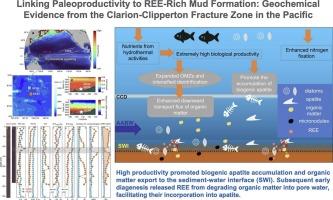古生产力与富稀土泥质地层的联系:来自太平洋克拉里昂-克利珀顿断裂带的地球化学证据
IF 3.6
2区 地球科学
Q1 GEOLOGY
引用次数: 0
摘要
富含稀土元素的深海沉积物被称为“稀土富泥”,是一种具有巨大经济潜力的有前途的资源。然而,古生产力在它们形成过程中的作用仍然知之甚少。本文研究了太平洋克拉里昂-克利珀顿断裂带(CCFZ)两个相邻沉积物岩心(GC02和GC03)的地球化学特征。与类镧和钇(ΣREY)平均浓度为477 ppm的GC03岩心相比,gco2中富ree泥体的平均ΣREY (843 ppm)显著升高,δ13CTOC和δ15N值较低。此外,富含稀土元素的泥浆含有高浓度的生物sio2和过量的Ba。这些地球化学特征表明富稀土泥沉积时期古生产力显著增强。GC02 δ15N值显著降低(平均5.9‰,GC03 δ15N值为9.9‰),表明渐新世高生产力触发了氧最小带(OMZs)的快速扩张,从而加剧了水柱反硝化作用,耗尽了区域氮储量。为了补偿氮的损失,发生了显著增强的固氮作用,维持了持续的高生产力水平。至关重要的是,海洋加工区的扩大减少了中远洋区有机物的降解,从而增加了其向海底的输出通量。在强烈的早期成岩作用中,有机质在沉积物-水界面分解释放出稀土元素,稀土元素随后被纳入高产能条件下形成的丰富的生物磷灰石中。本文章由计算机程序翻译,如有差异,请以英文原文为准。

Linking paleoproductivity to REE-rich mud formation: geochemical evidence from the Clarion-Clipperton Fracture Zone in the pacific
Deep-sea sediments enriched in rare earth elements, termed “REE-rich mud,” represent a promising resource with substantial economic potential. Nevertheless, the role of paleoproductivity in their formation remains poorly understood. In this study, we focus on the geochemical characteristics of two adjacent sediment cores (GC02 and GC03) from the Clarion-Clipperton Fracture Zone (CCFZ) in the Pacific. Compared to core GC03 with an average concentration of lanthanoids and yttrium (ΣREY) of 477 ppm, the REE-rich muds in GC02 show a significantly higher average ΣREY of 843 ppm, coupled with lower δ13CTOC and δ15N values. Additionally, the REE-rich muds contain elevated concentrations of bio-SiO2 and excess Ba. These geochemical features suggest markedly enhanced paleoproductivity during the deposition of the REE-rich muds. The significantly lower δ15N values in GC02 (averaging 5.9 ‰ vs. 9.9 ‰ in GC03) indicate that rapid expansion of oxygen minimum zones (OMZs) was triggered by high productivity, which intensified water-column denitrification and depleted the regional nitrogen inventory during the Oligocene. To compensate for nitrogen loss, significantly enhanced nitrogen fixation occurred, sustaining persistently high productivity levels. Crucially, the expansion of OMZs reduced the degradation of organic matter in the mesopelagic zone, thereby increasing its export flux to the seafloor. During intense early diagenesis, decomposition of this organic matter at the sediment–water interface released REE, which were subsequently incorporated into abundant biogenic apatite formed under high productivity.
求助全文
通过发布文献求助,成功后即可免费获取论文全文。
去求助
来源期刊

Ore Geology Reviews
地学-地质学
CiteScore
6.50
自引率
27.30%
发文量
546
审稿时长
22.9 weeks
期刊介绍:
Ore Geology Reviews aims to familiarize all earth scientists with recent advances in a number of interconnected disciplines related to the study of, and search for, ore deposits. The reviews range from brief to longer contributions, but the journal preferentially publishes manuscripts that fill the niche between the commonly shorter journal articles and the comprehensive book coverages, and thus has a special appeal to many authors and readers.
 求助内容:
求助内容: 应助结果提醒方式:
应助结果提醒方式:


